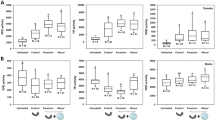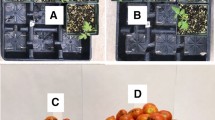Abstract
Insect-associated microbes can contribute to the physiological and ecological functions of insects. Despite a few examples in beetles and piercing-sucking insects, the varied mechanisms of how insect-associated bacteria mediate plant-insect interactions are still not fully understood. The polyphagous herbivore Helicoverpa zea is a major agricultural pest that harbors certain microbes in their digestive systems. Enterobacter ludwigii is one of the gut-associated bacteria identified from field-collected caterpillars, and it has been shown to indirectly induce defenses in the dicot plant tomato by triggering the biosynthesis of salivary elicitors, but there are no clear mechanisms to show how gut microbes alter these salivary cues and how a different host plant responds to these inducible elicitors. Here, we conducted a series of assays to determine whether infection with E. ludwigii affects H. zea larval growth, immunity, and salivary responses and thus influences induced defenses of maize to herbivory. Inoculating lab-reared caterpillars with E. ludwigii, did not significantly affect the growth of caterpillars, but two immunity-related genes glucose oxidase (GOX) and lysozyme (LYZ) were more highly expressed in both salivary glands and midguts compared with MgCl2 solution-treated caterpillars. Oral elicitors were evaluated for their role in triggering maize-specific defense responses. Our results show that saliva and its main component protein glucose oxidase (GOX) from E. ludwigii-inoculated caterpillars played a role in inducing maize anti-herbivore responses. These findings provide a novel concept that introducing bacteria to an herbivore may be an important approach to pest control through alteration of insect immune responses and thus indirect induction of plant resistance.







Similar content being viewed by others
Change history
13 June 2018
The original version of this article unfortunately contained a mistake. Fig. 3 and Fig. 4a were identical and the original version of Fig. 4a had been accidentally replaced.
References
Acevedo FE, Rivera-Vega LJ, Chung SH, Ray S, Felton GW (2015) Cues from chewing insects - the intersection of DAMPs, HAMPs, MAMPs and effectors. Curr Opin Plant Biol 26:80–86
Acevedo FE, Peiffer M, Tan CW, Stanley BA, Stanley A, Wang J, Jones AG, Hoover K, Rosa C, Luthe D, Felton GW (2017) Fall armyworm-associated gut bacteria modulate plant defense responses. Mol Plant-Microbe Interact 30:127–137
Akman GE, Douglas AE (2009) Symbiotic bacteria enable insect to use a nutritionally inadequate diet. Proc R Soc B Biol Sci 276:987–991
Alborn HT, Turlings TCJ, Jones TH, Stenhagen G, Loughrin JH, Tumlinson JH (1997) An elicitor of plant volatiles from beet armyworm oral secretion. Science 276:945–949
Bede JC, Musser RO, Felton GW, Korth KL (2006) Caterpillar herbivory and salivary enzymes decrease transcript levels of Medicago truncatula genes encoding early enzymes in terpenoid biosynthesis. Plant Mol Biol 60:519–531
Celorio-Mancera ML, Ytterberg AJ, Rutishauser D, Janz N, Zubarev RA (2015) Effect of host plant and immune challenge on the levels of chemosensory and odorant-binding proteins in caterpillar salivary glands. Insect Biochem Mol Biol 61:34–45
Chung SH, Rosa C, Scully ED, Peiffer M, Tooker JF, Hoover K, Luthe DS, Felton GW (2013) Herbivore exploits orally secreted bacteria to suppress plant defenses. Proc Natl Acad Sci U S A 110:15728–15733
Clark EL, Karley AJ, Hubbard SF (2010) Insect endosymbionts: manipulators of insect herbivore trophic interactions? Protoplasma 244:25–51
Diezel C, Von CC D, Gaquerel E, Baldwin IT (2009) Different lepidopteran elicitors account for cross-talk in herbivory-induced phytohormone signaling. Plant Physiol 150:1576–1586
Dow M, Newman M, Roepenack EV (2000) The induction and modulation of plant defense responses by bacterial lipopolysaccharides. Annu Rev Phytopathol 38:241–261
Eichenseer H, Mathews M, Bi JL, Murphy JB, Felton GW (1999) Salivary glucose oxidase: multifunctional roles for Helicoverpa zea? Arch Insect Biochem Physiol 109:99–109
Felton GW, Chung SH, Hernandez MGE, Louis J, Peiffer M, Tian D (2014) Herbivore oral secretions are the first line of protection against plant-induced defences. Pages 37–76 in Annual Plant Reviews, C. Voelckel and G. Jander, eds. Wiley
Hammer TJ, Janzen DH, Hallwachs W, Jaffe SP, Fierer N (2017) Caterpillars lack a resident gut microbiome. Proc Natl Acad Sci U S A 114:9641–9646
Hoffmann WA, Poorter H (2002) Avoiding bias in calculations of relative growth rate. Ann Bot 90:37–42
Hultmark D (1996) Insect lysozymes. In: Jollès P (ed) Lysozymes: model enzymes in biochemistry and biology. Birkhauser Verlag Basel, Switzerland, pp 87–102
Kohl KD, Dearing MD (2012) Experience matters: prior exposure to plant toxins enhances diversity of gut microbes in herbivores. Ecol Lett 15:1008–1015
Kwakman PHS, te Velde AA, de Boer L, Speijer D, Vandenbroucke-Grauls CMJE, Zaat SAJ (2010) How honey kills bacteria. FASEB J 24:2576–2582
Lemos FJ, Terra WR (1991) Digestion of bacteria and the role of midgut lysozyme in some insect larvae. Comp Biochem Physiol B 100:265–268
Liu F, Cui L, Cox-Foster D, Felton GW (2004) Characterization of a salivary lysozyme in larval Helicoverpa zea. J Chem Ecol 30:2439–2457
Livak KJ, Schmittgen TD (2001) Analysis of relative gene expression data using real-time quantitative PCR and the 2-ΔΔCt method. Methods 25:402–408
Louis J, Peiffer M, Ray S, Luthe DS, Felton GW (2013) Rapid report host-specific salivary elicitor (s) of European corn borer induce defenses in tomato and maize. New Phytol 199:66–73
Mason CJ, Couture JJ, Raffa KF(2014) Plant-associated bacteria degrade defense chemicals and reduce their adverse effects on an insect defoliator. Oecologia 175:901–910
Mohan S, Ma PW, Williams WP, Luthe DS (2008) A naturally occurring plant cysteine protease possesses remarkable toxicity against insect pests and synergizes Bacillus thuringiensis toxin. PLoS One 3:e1786
Moran NA, Russell JA, Koga R, Fukatsu T (2005) Evolutionary relationships of three new species of Enterobacteriaceae living as symbionts of aphids and other insects. Appl Environ Microbiol 71:3302–3310
Musser RO, Hum-Musser SM, Eichenseer H, Peiffer M, Ervin G, Murphy B, Felton GW (2002) Herbivory: caterpillar saliva beats plant defences. Nature 416:599–600
Musser RO, Kwon HS, Williams SA, White JC, Romano MA, Holt SM, Bradbury S, Brown JK, Felton GW (2005) Evidence that caterpillar labial saliva suppresses infectivity of potential bacterial pathogens. Arch Insect Biochem Physiol 58:138–144
Ohashi K, Natori S, Kubo T (1999) Expression of amylase and glucose oxidase in the hypopharyngeal gland with an age-dependent role change of the worker honeybee (Apis mellifera L.). Eur J Biochem 265:127–133
Peiffer M, Felton GW (2005) The host plant as a factor in the synthesis and secretion of salivary glucose oxidase in larval Helicoverpa zea. Arch Insect Biochem Physiol 58:106–113
Peiffer M, Felton GW (2009) Do caterpillars secrete “oral secretions”? J Chem Ecol 35:326–335
Qi J, Sun G, Wang L, Zhao C, Hettenhausen C, Schuman MC, Baldwin IT, Li J, Song J, Liu Z, Xu G, Lu X, Wu J (2016) Oral secretions from Mythimna separata insects specifically induce defence responses in maize as revealed by high-dimensional biological data. Plant Cell Environ 39:1749–1766
Ray S, Gaffor I, Acevedo FE, Helms A, Chuang WP, Tooker J, Felton GW, Luthe DS (2015) Maize plants recognize herbivore-associated cues from caterpillar frass. J Chem Ecol 41:781–792
Ray S, Basu S, Rivera-Vega LJ, Acevedo FE, Louis J, Felton GW, Luthe DS (2016) Lessons from the far end: Caterpillar frass-induced defenses in maize, rice, cabbage, and tomato. J Chem Ecol 42:1130–1141
Rivera-Vega LJ, Acevedo FE, Felton GW (2017) Genomics of Lepidoptera saliva reveals function in herbivory. Curr Opin Insect Sci 19:61–69
Schittko U, Preston CA, Baldwin IT (2000) Eating the evidence? Manduca sexta larvae cannot disrupt specific jasmonate induction in Nicotiana attenuata by rapid consumption. Planta 210:343–346
Schmelz EA (2015) Impacts of insect oral secretions on defoliation-induced plant defense. Curr Opin Insect Sci 9:7–15
Staudacher H, Kaltenpoth M, Breeuwer JAJ, Menken SB, Heckel DG, Groot AT (2016) Variability of bacterial communities in the moth Heliothis virescens indicates transient association with the host. PLoS One 11:e0154514
Tang Q, Hu Y, Kang L, Wang CZ (2012a) Archives of insect biochemistry and physiology characterization of glucose-induced glucose oxidase gene and protein expression in Helicoverpa armigera larvae. Arch Insect Biochem Physiol 79:104–119
Tang X, Freitak D, Vogel H, Ping L, Shao Y, Cordero EA, Andersen G, Westermann M, Heckel D, Boland W (2012b) Complexity and variability of gut commensal microbiota in polyphagous lepidopteran larvae. PLoS One 7:e36978
Tian D, Peiffer M, Shoemaker E, Tooker J, Haubruge E, Francis F, Luthe DS, Felton GW (2012) Salivary glucose oxidase from caterpillars mediates the induction of rapid and delayed-induced defenses in the tomato plant. PLoS One 7:e36168
Wang J, Peiffer M, Rosa C, Zeng R, Felton GW (2017) Helicoverpa zea gut-associated bacteria indirectly induce defenses in tomato through mediating salivary elicitor(s). New Phytol 214:1294–1306
Wu S, Peiffer M, Luthe DS, Felton GW (2012) ATP hydrolyzing salivary enzymes of caterpillars suppress plant defenses. PLoS One 7:e41947
Xiang H, Wei G, Jia S, Huang J, Miao X, Zhou Z, Zhao L, Huang YP (2006) Microbial communities in the larval midgut of laboratory and field populations of cotton bollworm ( Helicoverpa armigera ). Can J Microbiol 52:1085–1092
Zhu F, Poelman EH, Dicke M (2015) Insect herbivore-associated organisms affect plant responses to herbivory. New Phytol 204:315–321
Zong N, Wang C (2004) Induction of nicotine in tobacco by herbivory and its relation to glucose oxidase activity in the labial gland of three noctuid caterpillars. Chin Sci Bull 49:1596–1601
Acknowledgments
Many thanks to two anonymous reviewers and Michelle Peiffer and Rongrong Xue for providing very constructive comments for the manuscript. This research was supported by the National Science Foundation Grant (IOS-1256326), United States Department of Agriculture (AFRI 2017-67013-26596) awarded to G.W.F., C.R. and K.H., Research Project of Department of Education of Fujian for Young and Middle-age teachers (JAT170155), Talent Programs of Fujian Agriculture and Forestry University (KXJQ17013), Natural Science Foundation of Fujian Province (2018 J01712) and the National Natural Science Foundation of China (31701855) awarded to J.W.
Author information
Authors and Affiliations
Corresponding author
Additional information
The original version of this article was revised: The original version of this article unfortunately contained a mistake. Figure 3 and figure 4a were identical and the original version of figure 4a had been accidentally replaced. The correct version of figure 4a can be found below.
Electronic supplementary material
ESM 1
(DOCX 428 kb)
Rights and permissions
About this article
Cite this article
Wang, J., Yang, M., Song, Y. et al. Gut-Associated Bacteria of Helicoverpa zea Indirectly Trigger Plant Defenses in Maize. J Chem Ecol 44, 690–699 (2018). https://doi.org/10.1007/s10886-018-0970-0
Received:
Revised:
Accepted:
Published:
Issue Date:
DOI: https://doi.org/10.1007/s10886-018-0970-0




